The Acer Swift 3 SF314 Notebook Review: Swift Gets Swifter With Ryzen 4000
by Brett Howse & Andrei Frumusanu on May 5, 2020 8:00 AM ESTDisplay Analysis
Acer offers just a single display option on the 14-inch AMD based Swift 3, which is a 1920x1080 IPS display. Considering the price, this is the right option, although it is interesting that they are offering a 13.5-inch 3:2 Intel based Swift 3 in the SF313-52. The 3:2 works quite well for productivity, although less-so for gaming where 16:9 generally suffers from fewer issues.
There is no touch capability with this display, which is a bit of a shame, but also understandable with the other features offered. Acer did well to hit their target price range, and they made overall good decisions on where to invest. Touch is a nice to have, but not a necessity, although when you are used to having it, it is amazing how often you try to touch the screen.
To see how the display stacks up, the laptop was tested with Portrait Display’s CalMAN software suite. For brightness and contrast, the X-Rite i1Display Pro colorimeter was used, and for color accuracy readings the X-Rite i1Pro 2 spectrophotometer was employed.
Brightness and Contrast
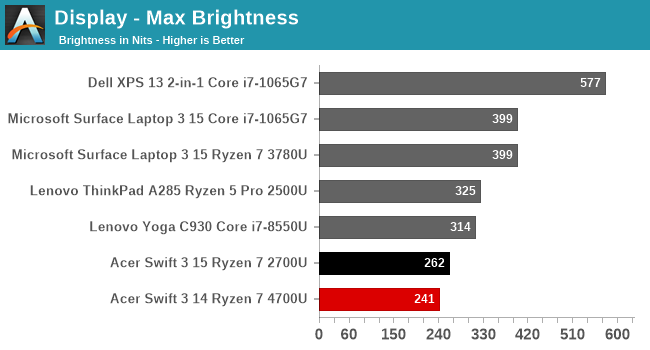
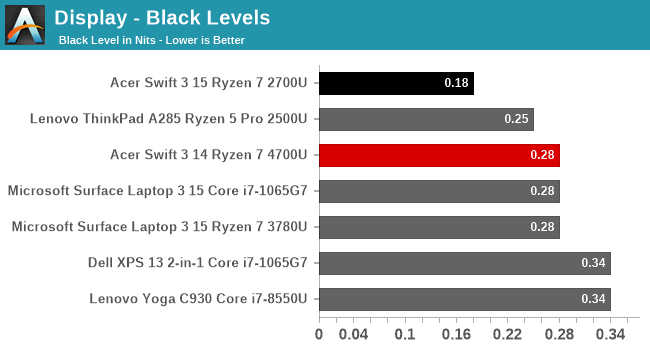
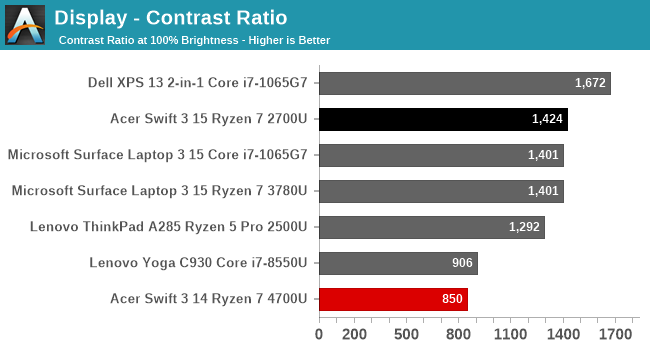
The Acer Swift 3 does not get off to a great start. In a budget notebook, displays tend to be one of the first things on the chopping block. Luckily, we’ve moved past the era where these types of notebooks would offer 1366x768 TN panels, but Acer’s 1920x1080 IPS choice doesn’t offer very good black levels, and their backlight is somewhat weak. It is an inauspicious start.
Grayscale

Grayscale measures the laptops ability to display white levels, from 0% (black) to 100% (white), and the Swift 3 performs quite poorly here. The blue levels are far too strong across most of the range. Gamma is also way off of the expected 2.2 level.
Gamut
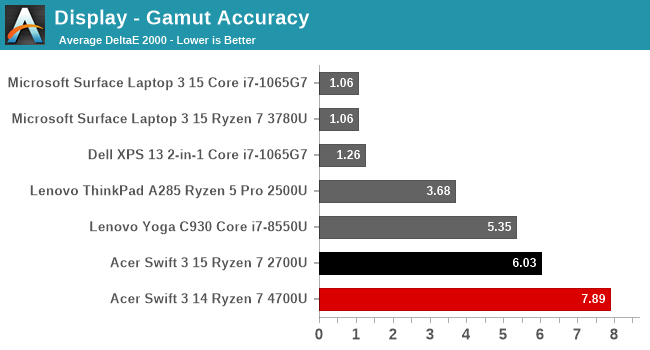
Windows 10 is still an sRGB system first and foremost, so proper sRGB gamut support is required for proper color accuracy. The Acer Swift 3 unfortunately does not cover anywhere near the sRGB gamut, which means that the LED backlighting was likely another area where some money was saved. Although grayscale can be salvaged with some ICC profiles, without full sRGB backlighting this laptop would likely suffer further if an ICC was applied because it simply cannot cover the entire sRGB spectrum.
Saturation
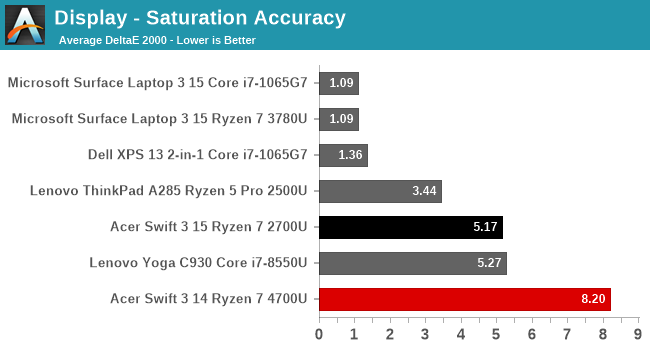
The saturation test covers the primary and secondary colors, but unlike the gamut where they are just measured at 100% level, we test them on 4-bit steps from 0% to 100%. Since we’ve already determined the laptop can’t hit the full sRGB gamut, it is no surprise to see the saturation sweeps suffer.
Gretag Macbeth
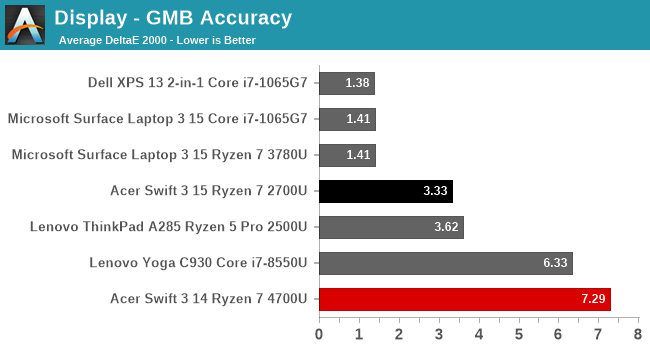
The Gretag Macbeth tests colors off of the primary and secondary axis, including the important skin tones, but with a display that can’t reproduce the entire sRGB range, the Acer Swift 3 naturally performs quite poorly on this test.
Colorchecker
Finally, we have the colorchecker, where you can more easily visualize the color errors with this display. This is a relative test, since any errors in your own display will influence the result, but on the bottom of the swatches is the color requested, and the top shows the color produced by the display. It is not pretty.
Display Conclusion
Overall, despite the poor showing here, the display is in-line with expectations at this price point. Over the last couple of years, there has been a push for better displays, and laptop makers have made the jump to 1920x1080 IPS panels pretty much across the board; so even though this display is poor compared to better IPS-based laptops, it still does offer the good viewing angles an IPS panel enjoys, and 1920x1080 works very well on a 14-inch screen size.
The very poor backlighting really does hamper the capabilities of this notebook. If you wanted to use it for editing photos or video, the internal components like the CPU, memory, and GPU, really would help, but the included display with its lack of sRGB coverage would certainly hinder the work. For basic office tasks, or even gaming, most people who are looking at a laptop at this price point will likely not be too concerned about the display, but just be aware that this one is deficient in several areas.


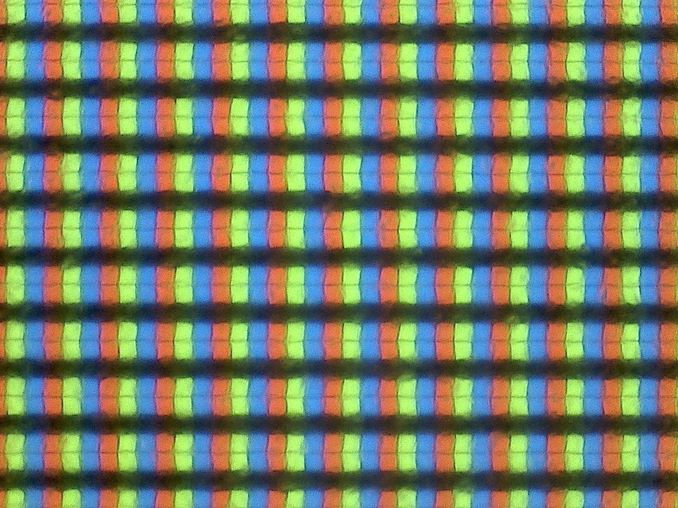













191 Comments
View All Comments
fmcjw - Tuesday, May 5, 2020 - link
Because over in Mac land they finally got the butterfly keyboard revolt over with and now talks can resume on the finer points of systems design. But it's not looking good for fine arts because the front burners have been conscripted for the A15 (MacOS on ARM) revolution.Spunjji - Wednesday, May 6, 2020 - link
Buying a CPU that doesn't have turbo is *not* a worthy trade-off unless you simply cannot afford anything better, because you'll be leaving a whole ton of performance on the table - especially when the device is plugged in.The 25% battery deficit isn't as simple as "more cores, more power" either - check out the Zephyrus G14 vs the Razer Blade 15 for a more appropriate comparison of well-designed devices. Put simply, that deficit has more to do with how this particular notebook was designed than it does to do with Ryzen 4000.
Focusing on single-thread performance when the vast majority of applications users interact with are multi-threaded doesn't really make sense, either. I'd recommend reading in a little more depth.
Omega215D - Tuesday, May 5, 2020 - link
Looks like we've got another piece of crap Intel fanboy here intent on spreading FUD on AMD's new mobile processors. So far reviews of the ASUS TUF featuring the new procs do far better on battery life and gaming performance.yeeeeman - Tuesday, May 5, 2020 - link
Looks like we've got another piece of crap AMD fanboy that cannot read the damn graphs.yankeeDDL - Tuesday, May 5, 2020 - link
The XPS and the Surface cost about twice as much as the Swift 3: they are high-end systems with high-end components, especially screens.Irata - Tuesday, May 5, 2020 - link
Actually the Dell's "as reviewed" price on At was $ 1,749.99, the Surface Laptop 3 with a 512GB SSD costs $ 2,199, so we are talking three times the price. The Yoga C930 is almost budget, costing only slightly less than twice as much as the Swift.yankeeDDL - Wednesday, May 6, 2020 - link
Thanks. You're right of course.Irata - Tuesday, May 5, 2020 - link
Eight cores vs. four cores....You have surely seen the battery life comparisons between Ryzen 4000 and Intel's eight core counterpart.
notb - Wednesday, May 6, 2020 - link
Number of cores is of less importance. Intel makes 16-core processors using 30W and 6-core chips using 100W.Comparison of 8-core SoCs are between chips made on TSMC 7N and Intel 14nm, which makes AMD much more efficient.
This comparison is for TSMC 7N vs Intel 10nm.
What matters is performance vs power and average these are similar. The gap will be minimal when Intel launches 6 or 8-core models later this year.
Spunjji - Wednesday, May 6, 2020 - link
Is there any evidence that Intel will be releasing 10nm 15W 6-8 core CPUs this year? I thought they were sticking with 4 cores on 10nm and releasing 6-8core 15W 14nm CPUs.